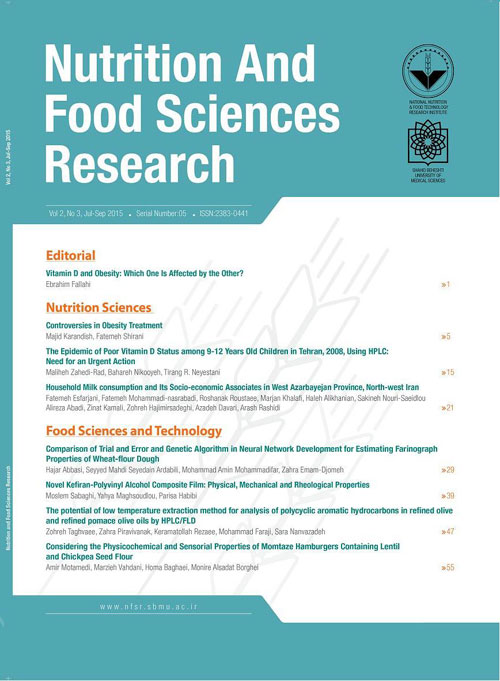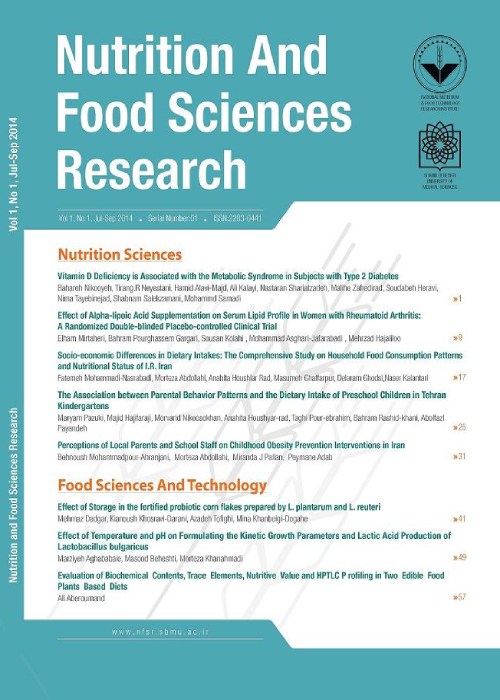فهرست مطالب

Nutrition & Food Technology Research
Volume:2 Issue: 3, Jul-Sep 2015
- تاریخ انتشار: 1394/05/16
- تعداد عناوین: 8
-
-
Pages 5-14The markedly high prevalence of obesity contributes to the increased incidence of chronic diseases, such as diabetes, hypertension, sleep apnea, and heart disease. Because of high prevalence of obesity in almost all countries, it has been the focus of many researches throughout the world during the recent decades. Along with increasing researches, new concepts and controversies have been emerged. The existing controversies on the topic are so deep that some researches argue on absolutely philosophical questions such as “Is obesity a disease?” or “Is it correct to treat obesity?” These questions are based on a few theories and real data that explain obesity as a biological adaptation and also the final results of weight loss programs. Many people attempt to lose weight by diet therapy, physical activity and lifestyle modifications. Importantly, weight loss strategies in the long term are ineffective and may have unintended consequences including decreasing energy expenditure, complicated appetite control, eating disorders, reducing self-esteem, increasing the plasma and tissue levels of persistent organic pollutants that promote metabolic complications, and consequently, higher risk of repeated cycles of weight loss and weight regain. In this review, major paradoxes and controversies on obesity including classic obesity paradox, pre-obesity; fat-but-fit theory, and healthy obesity are explained. In addition, the relevant strategies like “Health at Every Size” that emphasize on promotion of global health behaviors rather than weight loss programs are explained.Keywords: Obesity, Overweight, Obesity paradox, Fat, but, fit
-
Pages 15-20Background And ObjectivesVitamin D deficiency/insufficiency is a global health problem. The importance of this problem is doubled in growing children because of their increased need for skeletal growth. This investigation was performed firstly to assess vitamin D status, and secondly to examine its possible relationship with sex, residing area and duration of sun exposure in 9-12 years old children of Tehran.Materials And MethodsWe studied 257 randomly selected children out of 1111 children of a huge study, titled “Vitamin D and Calcium Deficiency Prevalence of Tehran’s Elementary School Children (VDPT)”, performed in fall and winter 2008 in Tehran. The children were without the history of diabetes, allergy or autoimmune disease, and any calcium, vitamin D and fish oil supplement use during the last three months. Venous blood samples were taken, and the sera were analyzed by high performance liquid chromatography (HPLC) for measuring 25-hydroxycalciferol (25(OH)D).ResultsThe participating children comprised of 53.7% girls and 46.3% boys from different economical areas of Tehran (40.5% poor, 26% middle and 33.5% rich). Their mean age was 10.1±0.7 years, mean duration of sun exposure was 41.2±34.6 min/day, and mean serum 25(OH)D concentration was 21.9±15.6 nmol/L. Duration of sun exposure was not significantly different either between boys and girls (p=0.220), among different residing areas (p= 0.057), or between the girls and boys of different areas. The occurrence of vitamin D deficiency was 72.4% (n=186). Vitamin D status was significantly different between boys and girls (p= 0.01) and among the areas (P= 0.004). There was no significant relation between poor vitamin D status and duration of sun exposure (p=0.411).ConclusionsThe findings showed a noticeable occurrence of vitamin D deficiency/insufficiency among 9-12 years old children in Tehran. The data warrants urgent interventions.Keywords: Vitamin D, 25, hydroxycalciferol, School children
-
Pages 21-27Background And ObjectivesAccording to the available evidence, consumption of milk and other dairy products among Iranians is far less than recommendations. The share of different milks (i.e., traditionally vs. industrially processed) and its associated variables are, however, neither consistent nor fully known in different Provinces.Materials And MethodsThis cross-sectional study was conducted to determine household milk consumption and its association with selected socio-demographic factors in West Azarbayejan Province, North-west Iran. A total of 650 households were selected from urban and rural areas in three major Azeri and Kurdish districts (i.e. Urmia, Khoy and Mahabad) using a multi-stage cluster sampling method. Data were collected using socio-economic and milk frequency questionnaires.ResultsThe findings indicated that traditionally-processed milk (bulk) was the most common milk consumed at household level (62.5%). Mean of bulk milk consumption in urban and rural areas was 479±23 and 730±64 ml/wk per capita, respectively. It was also shown that establishment of the new food subsidization policy has decreased the mean of household milk consumption by approximately 3 l/wk in urban areas. Factor analysis detected a significant decrease in the higher tertiles of family size/ethnicity score consumption of both bulk and pasteurized milk, which resulted in decreased consumption of total milk.ConclusionsDesigning and implementation of alternative approaches, such as targeted milk subsidies for poor households or vulnerable age-groups should be considered.Keywords: Household milk consumption, Milk processing method, Socio, economic variables, Iran
-
Pages 29-38Background And ObjectivesRheological characteristics of dough are important for achieving useful information about raw-material quality, dough behavior during mechanical handling, and textural characteristics of products. Our purpose in the present research is to apply soft computation tools for predicting the rheological properties of dough out of simple measurable factors.Materials And MethodsOne hundred samples of white flour were collected from different provinces of Iran. Seven physic-chemical properties of flour and Farinogram parameters of dough were selected as neural network’s inputs and outputs, respectively. Trial-and-error and genetic algorithm (GA) were applied for developing an artificial neural network (ANN) with an optimized structure. Feed-forward neural networks with a back-propagation learning algorithm were employed. Sensitivity analyses were conducted to explore the ability of inputs in changing the Farinograph properties of dough.ResultsThe optimal neural network is an ANN-GA that evolves a four-layer network with eight nodes in the first hidden layer and seven neurons in the second hidden layer. The average of normalized mean square error, mean absolute error and correlation coefficient in estimating the test data set was 0.222, 0.124 and 0.953, respectively. According to the results of sensitivity analysis, gluten index was selected as the most important physicochemical parameter of flour in characterization of dough’s Farinograph properties.ConclusionsAn ANN is a powerful method for predicting the Farinograph properties of dough. Taking advantages of performance criteria proved that the GA is more powerful than trial-and-error in determining the critical parameters of ANN’s structure, and improving its performance.Keywords: Artificial neural network, Genetic algorithm, Rheological characterization, Wheat, flour dough
-
Pages 39-46Background And ObjectivesKefiran (Kef) is a water-soluble polysaccharide that can form transparent film; however, it is brittle. Therefore, in order to improve the mechanical properties of kefiran film, a mixture with other polymers can be offered. The expansion of mixed systems can propose kefiran and polyvinyl alcohol (PVOH) as a new composite film.Materials And MethodsSolutions of 20 gram per liter kef and 40 gram per liter of PVOH were prepared. A mixture of film-forming solutions of different ratios of Kef/PVOH (100/0, 68/32, 50/50, 32/68) was prepared. In this study, different experiments including the physical properties (thickness, moisture content, and film solubility in water), water vapor permeability, and mechanical properties (tensile strength, elongation at break, puncture strength, and puncture deformation) of composite films as well as the rheological properties of film forming solutions were investigated.ResultsThe results of physical properties such as thickness, moisture content, solubility in water and mechanical properties such as tensile strength, elongation at break, puncture deformation, puncture strength and water vapor permeability indicated that the mechanical properties, thickness and solubility in water increase with increase in PVOH content; however, moisture content and water vapor permeability decrease. Rheological characterization of different film forming solutions exhibited Newtonian fluid behavior.ConclusionsThese results contribute to the establishment of an approach to optimize films’ composition based on the interactions between polymers, aiming at improving the properties of polysaccharide-based films.Keywords: Kefiran, Polyvinyl alcohol, Physical properties, Mechanical properties, Rheological properties
-
Pages 47-54Background And ObjectivesA method was developed and validated for determining 15 polycyclic aromatic hydrocarbons (PAHs) in refined olive and refined pomace olive oils using high performance liquid chromatography coupled with a fluorescence detector.Materials And MethodsThe sample preparation involved liquid–liquid extraction with organic solvent and low temperature clean-up. The low temperature allowed most of the lipids in the extract to be removed. Then alumina-N and NH2 solid phase extraction cartridges were used for further clean-up.ResultsThe results showed that the obtained chromatogram of extract was free of significant interferences. The PAH recoveries ranged from 81% to 114 %. Limit of detection and limit of quantitation for individual PAHs were 0.09-1.97 µgkg-1 and 0.29-5.99 µgkg-1, respectively.ConclusionsThe performance of the present method was evaluated for determining PAHs in various types of real refined olive and refined pomace olive oil samples, and suitable results were obtained. The variable levels of PAHs were detected to range from 0.29 to 8.21µgkg-1 in real samples.Keywords: Polycyclic aromatic hydrocarbons (PAHs), Refined olive oil, Refined pomace olive oil, Low temperature extraction, High performance liquid chromatography with fluorescence detection (HPLC, FLD)
-
Pages 55-62Background And ObjectivesThe food product known as the ‘hamburger’ plays a crucial role in people’s nutrition and the diversity of the food they consume. The reasons for our study include the area under cultivation, the remarkable amount of protein in chickpeas and lentils, as well as the public interest in tending to meat products, especially hamburgers.Materials And MethodsIn this study, beef burgers were combined with chickpea flour and lentil flour at 4%, 8% and 12% levels. We evaluated the properties of uncooked beef burgers, including protein, fat, moisture, ash, pH, texture profile (hardness, springiness, cohesiveness, gumminess and chewiness), cooking properties, and sensory attributes.ResultsCompared with the controls, the percentage of the samples’ protein and fat increased with the rise in the level of chickpea and lentil flour. At 12% level, the chickpea and lentil flour had the lowest ash content. Samples of hamburgers with lentil flour at 12% level had the highest pH value. The hardness, chewiness and gumminess value of the samples significantly increased with increase in the level of chickpea and lentil flour, compared to the controls. At the level of 12%, the lentil flour had the lowest shrinkage percentage. Scores for all sensory parameters except for appearance decreased with increase in the level of extension.ConclusionsWe successfully produced a new product with significant nutritional value, cooking features and acceptable sensory-textural properties. Hamburger with 4% content of chickpea or lentil flour had sensory properties similar to the control, and was rated close to very good. Further research should be focused on the optimized use of amounts of legumes in hamburger.Keywords: Chickpea flour, Formulation, Hamburger, Lentil flour, Physico, chemical properties


